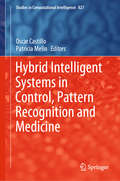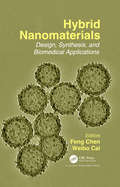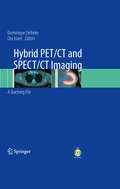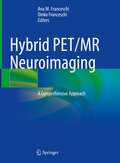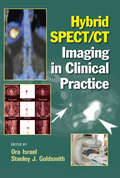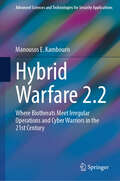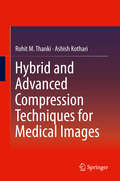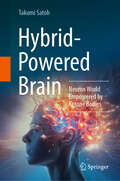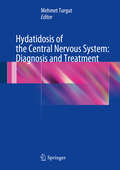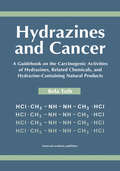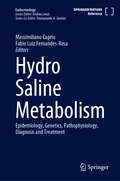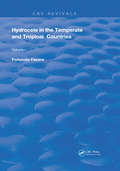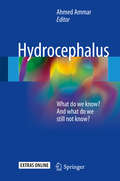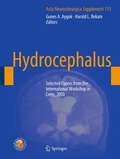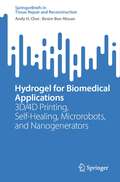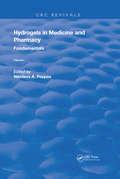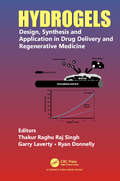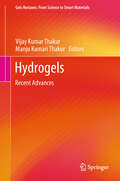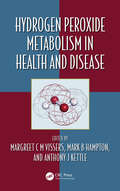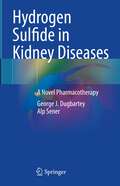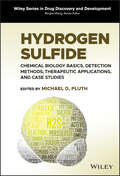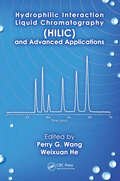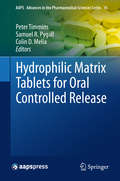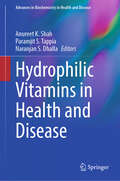- Table View
- List View
Hybrid Intelligent Systems in Control, Pattern Recognition and Medicine (Studies in Computational Intelligence #827)
by Oscar Castillo Patricia MelinThis book describes the latest advances in fuzzy logic, neural networks and optimization algorithms, as well as their hybrid combinations, and their applications in areas such as: intelligent control and robotics, pattern recognition, medical diagnosis, time series prediction, and optimization of complex problems. The book is divided into five main parts. The first part proposes new concepts and algorithms based on type-1 and type-2 fuzzy logic and their applications; the second explores new concepts and algorithms in neural networks and fuzzy logic applied to recognition. The third part examines the theory and practice of meta-heuristics in various areas of application, while the fourth highlights diverse applications of fuzzy logic, neural networks and hybrid intelligent systems in medical contexts. Finally, the fifth part focuses on applications of fuzzy logic, neural networks and meta-heuristics to robotics problems.
Hybrid Nanomaterials: Design, Synthesis, and Biomedical Applications
by Feng Chen Weibo CaiOver the last decade, an unprecedented expansion in the field of nanomedicine has resulted in the development of new nanomaterials for diagnosis and therapy of various diseases such as cancer. This book covers the design, synthesis and applications of various functionally-hybridized nanomaterials for biomedical applications. It includes strategies for design and synthesis of hybrid nanomaterials, surface engineering of various nanoparticle-based hybrid nanosystems for cancer imaging and therapy, toxicity aspects of nanomaterials and the challenges in translation research of hybrid nanomaterials.
Hybrid PET/CT and SPECT/CT Imaging
by Ora Israel Dominique DelbekeThis practical guide is a reference source of cases for images obtained on state-of-the-art integrated PET/CT and SPECT/CT imaging systems. It covers the full spectrum of clinical applications, including head and neck tumors, breast cancer, colorectal cancer, pancreatic cancer, and genitourinary tumors. In addition a wealth of illustrations reinforce the key teaching points discussed throughout the book.
Hybrid PET/MR Neuroimaging: A Comprehensive Approach
by Dinko Franceschi Ana M. FranceschiThis book serves as a reference and comprehensive guide for PET/MR neuroimaging. The field of PET/MR is rapidly evolving, however, there is no standard resource summarizing the vast information and its potential applications. This book will guide neurological molecular imaging applications in both clinical practice and the research setting. Experts from multiple disciplines, including radiologists, researchers, and physicists, have collaborated to bring their knowledge and expertise together. Sections begin by covering general considerations, including public health and economic implications, the physics of PET/MR systems, an overview of hot lab and cyclotron, and radiotracers used in neurologic PET/MRI. There is then coverage of each major disease/systemic category, including dementia and neurodegenerative disease, epilepsy localization, brain tumors, inflammatory and infectious CNS disorders, head and neck imaging, as well as vascular hybrid imaging. Together, we have created a thorough, concise and up-to-date textbook in a unique, user-friendly format. This is an ideal guide for neuroradiologists, nuclear medicine specialists, medical physicists, clinical trainees and researchers.
Hybrid SPECT/CT Imaging in Clinical Practice
by Ora Israel Stanley J. GoldsmithExploring a technology that is significantly impacting the noninvasive evaluation of the physiology and anatomy of tumors, as well as the diagnosis of infectious processes and cardiac diseases, this source presents recent advances and clinical applications of sequential, single session single-photon emission computed tomography and computed tomogra
Hybrid Warfare 2.2: Where Biothreats Meet Irregular Operations and Cyber Warriors in the 21st Century (Advanced Sciences and Technologies for Security Applications)
by Manousos E. KambourisThe concept of Hybrid Warfare has gained prominence in recent decades. It is a novel terminology, but the concept is detectable since antiquity: Ancient Chinese, Ancient Greeks and the Jews of Exodus were all well familiar, so well to have let us know. Similarly, bioagents have been used malevolently since always. What is novel is that these two, in the present context, are not only interfacing smoothly, but in an enhanced context: The Hybrid Warfare, which has now enriched its portfolio, from actions of provocation, insurgency, economic warfare, special operations, proxy warfare and social destabilization to the Residual domain, the cyberspace, while the conventional, 3D space expands. Now the Space and the Deep are included in the topography of the friction zone. In this, the bio- factor becomes not only relevant but also an amplifier: using the technology malevolently, all the advances made to combat disease may be used to cause, further, or perplex and complicate disease. Improved or totally novel or even alien germs may replace explosives in bombs, shells or suicidal /kamimaze drones and taint bullets and fragments. Microrobots may deliver cancer cells to targeted individuals to foster cancer, or specific supergerms for an infection to rage unchallenged. And what happens if the mechanism of these cancers and infections is intentionally provided with an Abort signal? Global extortions would become probable, not just possible. Far from Science Fiction, this dystopia becomes more probable by the day. The Artificial Intelligence simply makes it easier to occur. Technology allows manipulation and intervention in levels and extends only imagined in the Past, but the application of these capabilities is clearly of dual use, with the destructive potential leveraged by the complexity of the social and state structure. Within this book, we explore the “How” (occasionally the “What” also) in some of these instances. From cyber terrorists to aggressive bioindustrialists and “democratized” ballistic and cruise missile technology, it could be coined as "The Book of Modern Mayhem”.
Hybrid and Advanced Compression Techniques for Medical Images
by Rohit M. Thanki Ashish KothariThis book introduces advanced and hybrid compression techniques specifically used for medical images. The book discusses conventional compression and compressive sensing (CS) theory based approaches that are designed and implemented using various image transforms, such as: Discrete Fourier Transform (DFT), Discrete Cosine Transform (DCT), Discrete Wavelet Transform (DWT), and Singular Value Decomposition (SVD) and greedy based recovery algorithm. The authors show how these techniques provide simulation results of various compression techniques for different types of medical images, such as MRI, CT, US, and x-ray images. Future research directions are provided for medical imaging science. The book will be a welcomed reference for engineers, clinicians, and research students working with medical image compression in the biomedical imaging field. Covers various algorithms for data compression and medical image compression;Provides simulation results of compression algorithms for different types of medical images;Provides study of compressive sensing theory for compression of medical images.
Hybrid-Powered Brain: Neuron World Empowered by Ketone Bodies
by Takumi SatohThis book unlocks the secrets of a powerful and sustainable brain, as well as explores the concept of a hybrid-powered brain and the transformative potential of the "Small Ketogenic" system.Supplying the brain with an ample energy substrate is vital for a positive mindset and a fulfilling day. Adequate energy fuels sharp thinking and clear judgement, while an energy-deficient brain leads to a variety of problems. Low blood glucose levels make it difficult to remember and amplify negative emotions. Delve into the brain's often-overlooked energy system to avoid these situations.The human brain functions on two energy systems: glucose from carbohydrates and ketone bodies from fats. These systems complement each other, and activating the hybrid system is surprisingly simple. Adopting the "Small Ketogenic" means extending the intervals between meals and allowing for a slight feeling of hunger within a reasonable range. This approach preserves cognitive function to the maximum.Inspired by the longevity of individuals in certain villages, the hybrid-powered brain enhances mental vitality. These villagers lead vibrant lives fuelled by their powerful minds. Maintaining ketone body concentrations between 0.2-0.5 mM ensures an active and calm brain. By making slight adjustments in eating habits, and adopting the "Small Ketogenic", we can achieve healthy longevity. This sustainable approach boosts the brain and promotes optimal health effects.Embark on a transformative journey of self-improvement and discover the true potential of your brain. This book revolutionises the way you perceive and care for your brain, leading you to a sustainable and fulfilling cognitive existence.
Hydatidosis of the Central Nervous System: Diagnosis and Treatment
by Mehmet TurgutHydatid disease, a zoonotic infection caused by a tapeworm of the genus Echinococcus, has been encountered in various organs in humans. In spite of all the advances in imaging techniques and therapeutic methods, hydatidosis of the central nervous system is still a life-threatening condition in infested areas of the world. This is the first comprehensive reference book on hydatidosis of the central nervous system. It is written and edited by leading international authorities from infested areas and provides an in-depth review of diagnosis and management. Clinical and neuroradiological findings are extensively documented with the aid of numerous original photographs and the role of surgical intervention and chemotherapy is carefully appraised. In addition, future avenues and innovative therapeutic philosophies are discussed. This book will serve as an ideal source of up-to-date information for all with an interest in this debilitating disease.
Hydrazines and Cancer: A Guidebook on the Carciognic Activities of Hydrazines, Related Chemicals, and Hydrazine Containing Natural Products
by Bela TothThis comprehensive publication on biological actions of hydrazines includes all the available published material and chronological descriptions of the literature. The uniformly applied principle of evaluations separates each hydrazine chemical and divides according to species. This monograph presents data on carcinogenic activity of hydrazines in a
Hydro Saline Metabolism: Epidemiology, Genetics, Pathophysiology, Diagnosis and Treatment (Endocrinology)
by Massimiliano Caprio Fabio Luiz Fernandes-RosaThis book provides an overview of endocrine diseases associated with alterations of salt metabolism, with a focus on clinical and pathophysiological aspects. It covers various topics in the endocrine control of salt and water homeostasis, such as neuroendocrine determinants of water balance, adrenal hormone biosynthesis, hormonal function in target renal cells, and dysfunction of hormonal target effectors in the kidney. It also features an update on the clinical management of these diseases, including new diagnostic and therapeutic tools. Written by a combination of recognized and emerging experts in the field, this book is intended as a major reference work, not only for endocrinologists and nephrologists, but also for pediatricians, neonatologists, cardiologists, and emergency medicine and intensive care specialists, who can be faced with the management of endocrine diseases responsible of salt and water imbalance. The book is part of the SpringerReference program, which provides access to ‘living editions’ that are constantly updated using a dynamic, peer-review publishing process.
Hydrocele in the Temperate and Tropical Countries: Volume 1 (Routledge Revivals)
by Fortunato FasanaFirst published in 1983: This monograph is intended to collate hundreds of studies found in the literature; part of it consists of personal observations made and experience acquired in India, Uganda, and Kenya over the past 30 years.
Hydrocephalus
by Ahmed AmmarThis book provides the reader with a well-structured, comprehensive approach to hydrocephalus and related syndromes. It also addresses the ethical dilemmas of managing hydrocephalus, of which many neurosurgeons are unaware, and presents cutting-edge research genetic and pathophysiology research on hydrocephalus. The book presents a new classification for the Dandy Walker syndrome, based on a new understanding of different hydrocephalic problems. Further, it puts forward a wholly new theory on the pathophysiology and development of multiloculated hydrocephalus. This book helps the reader to devise a long-term strategic plan to treat patients, based on research of favorable long-term outcomes of hydrocephalus. It uniquely provides evidence-based approaches to managing hydrocephalus, presenting the experience and thoughts of renowned and highly experienced neurosurgeons from the USA, Canada, Japan, Europe and the Middle East.
Hydrocephalus
by Gunes A. Aygok Harold L. RekateThe contributions in this volume, presented at the 5th International Hydrocephalus Workshop in May 2010 in Crete, Greece, give the present state-of-the-art in timely diagnosis and treatment of hydrocephalus. The topics covered include advances in management of both pediatric and adult hydrocephalus, identifying shunt responders, clinical experiences in endoscopic third ventriculostomy, clinical trials, pathophysiology, experimental studies, and the new classification for hydrocephalus.
Hydrogel for Biomedical Applications: 3D/4D Printing, Self-Healing, Microrobots, and Nanogenerators (Tissue Repair and Reconstruction)
by Besim Ben-Nissan Andy H. ChoiThis book highlights the latest clinical research and advancements in 3D (bio)printing and 4D printing using stimulus-responsive hydrogels as well as the concept of self-healing and its amalgamation with 3D printed injectable cell-laden tissue constructs. It also explores the use of metal-free “click” chemistry and enzymes such as horseradish peroxidase, hematin, tyrosinase, and transglutaminase to obtain chemically crosslinked hydrogels and the in vitro and in vivo responses. Lastly, the book briefly examines the future of drug delivery and the potentials offered by microrobotics and self-powered devices based on triboelectric nanogenerators. This book caters to biomedical researchers and clinical practitioners working in tissue reconstruction and drug/therapeutic delivery.
Hydrogels in Medicine and Pharmacy: Fundamentals (Routledge Revivals #1)
by Nikolaos A. PeppasFirst Published in 1986, this book offers a full, comprehensive guide to the application of hydrogels in medicine. Carefully compiled and filled with a vast repertoire of notes, diagrams, and references this book serves as a useful reference for students of medicine and other practitioners in their respective fields.
Hydrogels: Design, Synthesis and Application in Drug Delivery and Regenerative Medicine
by Thakur Raghu Singh Garry Laverty Ryan DonnellyHydrogels are crosslinked, macromolecular polymeric materials arranged in a three-dimensional network, which can absorb and retain large amounts of water. Hydrogels are commonly used in clinical practice and experimental medicine for a wide range of applications, including drug delivery, tissue engineering and regenerative medicine, diagnostics, cellular immobilization, separation of biomolecules or cells, and barrier materials to regulate biological adhesions. This book elucidates the underlying concepts and emerging applications of hydrogels and will provide key case studies and critical analysis of the existing research.
Hydrogels: Recent Advances (Gels Horizons: From Science to Smart Materials)
by Vijay Kumar Thakur Manju Kumari ThakurThis book discusses recent advances in hydrogels, including their generation and applications and presents a compendium of fundamental concepts. It highlights the most important hydrogel materials, including physical hydrogels, chemical hydrogels, and nanohydrogels and explores the development of hydrogel-based novel materials that respond to external stimuli, such as temperature, pressure, pH, light, biochemicals or magnetism, which represent a new class of intelligent materials. With their multiple cooperative functions, hydrogel-based materials exhibit different potential applications ranging from biomedical engineering to water purification systems. This book covers key topics including superabsorbent polymer hydrogel; intelligent hydrogels for drug delivery; hydrogels from catechol-conjugated materials; nanomaterials loaded hydrogel; electrospinning of hydrogels; biopolymers-based hydrogels; injectable hydrogels; interpenetrating-polymer-network hydrogels: radiation- and sonochemical synthesis of micro/nano/macroscopic hydrogels; DNA-based hydrogels; and multifunctional applications of hydrogels. It will prove a valuable resource for researchers working in industry and academia alike.
Hydrogen Peroxide Metabolism in Health and Disease (Oxidative Stress and Disease)
by Mark Hampton Margreet C Vissers Anthony J. KettleMuch of the biology of oxidative stress and oxidative signalling centres on the generation and handling of hydrogen peroxide. The overall aim for this book would be to provide an insightful and useful forum to assist with the understanding of the relevance of hydrogen peroxide generation and how this is managed in human biology. The target audience would be those who currently have an interest in the generation of ROS, but who do not have expertise in chemistry, as well as those experts in the chemistry of oxidative stress, but without detailed understanding of the biologically relevant setting. We would aim to bridge the gap in understanding between chemistry and biology.
Hydrogen Sulfide and its Therapeutic Applications
by Hideo KimuraThe metabolism of sulfur especially by sulfurtransferases had been intensively studied in mid 1900's. Three enzymes, cystathionine β-synthase (CBS), cystathionine γ-lyase (CSE) and 3-mercaptopyruvate sulfurtransferase (3MST) were found to have the capacity to produce H2S in vitro. However, H2S was recognized simply as a by-product of the metabolic pathways or as a marker for evaluating the activity of enzymes rather than as a physiological active molecule. In the late 1980's relatively high concentrations of sulfide were measured in the brain that led to the successive studies of identifying the physiological functions of H2S. Recently, the steady-state concentrations of H2S have been re-evaluated and found to be much less than that initially measured. However, despite these differences, such re-evaluations served to further confirm the existence of H2S in mammalian tissues. H2S is produced in almost every organ and plays various roles such as neuromodulation, vasodilation, insulin release, inflammation, angiogenesis and cytoprotection. The unregulated production of H2S and improper responses of target molecules are involved in the pathogenesis of various diseases. This book focuses on these topics as well as on the recent progress in the biology and the therapeutic development of this molecule.
Hydrogen Sulfide in Kidney Diseases: A Novel Pharmacotherapy
by George J. Dugbartey Alp SenerThis book will be the first book that presents the beneficial effects of hydrogen sulfide in the treatment of various kidney pathologies. Hydrogen sulfide (H2S), a gas with a distinctive smell of rotten eggs, was known for over three centuries for its toxicity and death at high concentrations especially among agricultural and industrial workers. This is due to its ability to reversibly antagonize complex IV of the mitochondrial electron transport chain. However, studies over the past two decades have shown that H2S has risen above its historic notorious label and has received significant experimental attention as an endogenously produced gaseous signaling molecule that plays an important role in cellular homeostasis and influences a myriad of physiological and pathological processes at low concentrations. Its production is enzymatically regulated and has specific molecular targets. Several recent in vitro and in vivo studies have demonstrated that at low micromolar concentrations, H2S exhibits important therapeutic characteristics that target multiple molecular pathways and thereby preventing the development and progression of several pathologies.This beneficial effect of H2S suggests that it may meet the demand for alternative and/or additional therapeutic agents against various renal pathologies in which reduced levels of renal and plasma H2S were observed. Interestingly, while the distribution of H2S-producing enzymes is tissue-specific, they are abundantly expressed in the glomeruli and in the brush border and cytoplasm of epithelial cells of the renal tubules and in the peritubular capillaries. This makes the kidney a rich source of endogenous H2S production. From pre-clinical and clinical perspectives, this book is topical and timely, and seeks to lay the foundation for future clinical applications of H2S in nephrology.
Hydrogen Sulfide: Chemical Biology Basics, Detection Methods, Therapeutic Applications, and Case Studies (Wiley Series in Drug Discovery and Development)
by Binghe WangHYDROGEN SULFIDE Covers H2S interactions, methods of detection and delivery in biological environments, and a wide range of applications Research on hydrogen sulfide (H2S) spans diverse disciplines including chemistry, biology, and physiology. In recent years, new materials and approaches have been developed to deliver H2S and related reactive sulfur species in various clinical contexts. Although many biological pathways involving H2S are complex, all are governed by fundamental chemical interactions between reactive sulfur species and other molecular entities. Hydrogen Sulfide: Chemical Biology Basics, Detection Methods, Therapeutic Applications, and Case Studies provides the foundation required for understanding the fundamental chemical biology of H2S while highlighting the compound’s therapeutic potential and medicinal applications. This book covers key aspects of H2S chemical biology, including the fundamental chemistry of reactive sulfur species; the measurement, detection, and delivery of H2S in biological environments; and the therapeutic and medicinal uses of exogenous H2S delivery in various pharmacologically relevant systems. Throughout the text, editor Michael Pluth and chapter contributors discuss the opportunities and future of the multidisciplinary field. Provides approaches for delivering H2S with relevance to biological and therapeutic applications Describes complex interactions of H2S with bioinorganic complexes and reactive sulfur, nitrogen, and oxygen species Summarizes advances in available tools to detect, measure, and modulate H2S levels in biological environments, such as real-time methods for H2S fluorescence imaging in live cell and animal systems Helps readers understand known systems and make connections to new and undiscovered pathways and mechanisms of action Includes in-depth case studies of different systems in which H2S plays an important role Hydrogen Sulfide: Chemical Biology Basics, Detection Methods, Therapeutic Applications, and Case Studies is an important source of current knowledge for researchers, academics, graduate students, and industrial scientists in the fields of redox biology, hydrogen sulfide research, and medicinal chemistry of small biological molecules.
Hydrophilic Interaction Liquid Chromatography (Chromatographic Science Series)
by Perry G. Wang Weixuan HeThis is the first book that comprehensively and systematically describes the new technology of hydrophilic interaction liquid chromatography (HILIC). Hydrophilic interaction chromatography is a separation technique suitable for polar and hydrophilic compounds and orthogonal to reversed phase liquid chromatography. From small organic molecules to pr
Hydrophilic Matrix Tablets for Oral Controlled Release
by Peter Timmins Samuel R. Pygall Colin D. MeliaThis detailed volume addresses key issues and subtle nuances involved in developing hydrophilic matrix tablets as an approach to oral controlled release. It brings together information from more than five decades of research and development on hydrophilic matrix tablets and provides perspective on contemporary issues. Twelve comprehensive chapters explore a variety of topics including polymers (hypromellose, natural polysaccharides and polyethylene oxide) and their utilization in hydrophilic matrices, critical interactions impacting tablet performance, in vitro physical and imaging techniques, and microenvironmental pH control and mixed polymer approaches, among others. In one collective volume, Hydrophilic Matrix Tablets for Oral Controlled Release provides a single source of current knowledge, including sections of previously unpublished data. It is an important resource for industrial and academic scientists investigating and developing these oral controlled release formulations.
Hydrophilic Vitamins in Health and Disease (Advances in Biochemistry in Health and Disease #29)
by Naranjan S. Dhalla Paramjit S. Tappia Anureet K. ShahMore than 100 years ago, Dr Casimir Funk suggested the existence of a family of organic substances that are essential for life and thus introduced the concept of “vital amines” as essential nutrients with a specific action, requiring only minute amount with the power to cure a specific disease. Vitamins essential for human health are grouped according to whether they are soluble in water (hydrophilic) or in non-polar solvents (lipophilic). The hydrophilic vitamins are vitamin C and a series known as the vitamin B complex. Vitamin C is a reducing agent, whereas the vitamin B series are components of coenzymes. For example, riboflavin (vitamin B2) is a precursor of flavin adenine dinucleotide (FAD) and pantothenate (vitamin B5) is a component of coenzyme A. Indeed, several coenzymes contain a vitamin as part of their structure; this relation is undoubtedly responsible for creating an “essential” role for the vitamin. Since vitamins are involved in a wide range of biological processes and cell function, these are considered as essential nutrients. The essential nature of vitamins as well as their unique biochemistry, molecular mechanisms and cellular function in health and disease are emphasized in this book which will serve as a highly useful resource for health professionals, nutritional scientists, medical students, fellows, residents, and graduate students.
